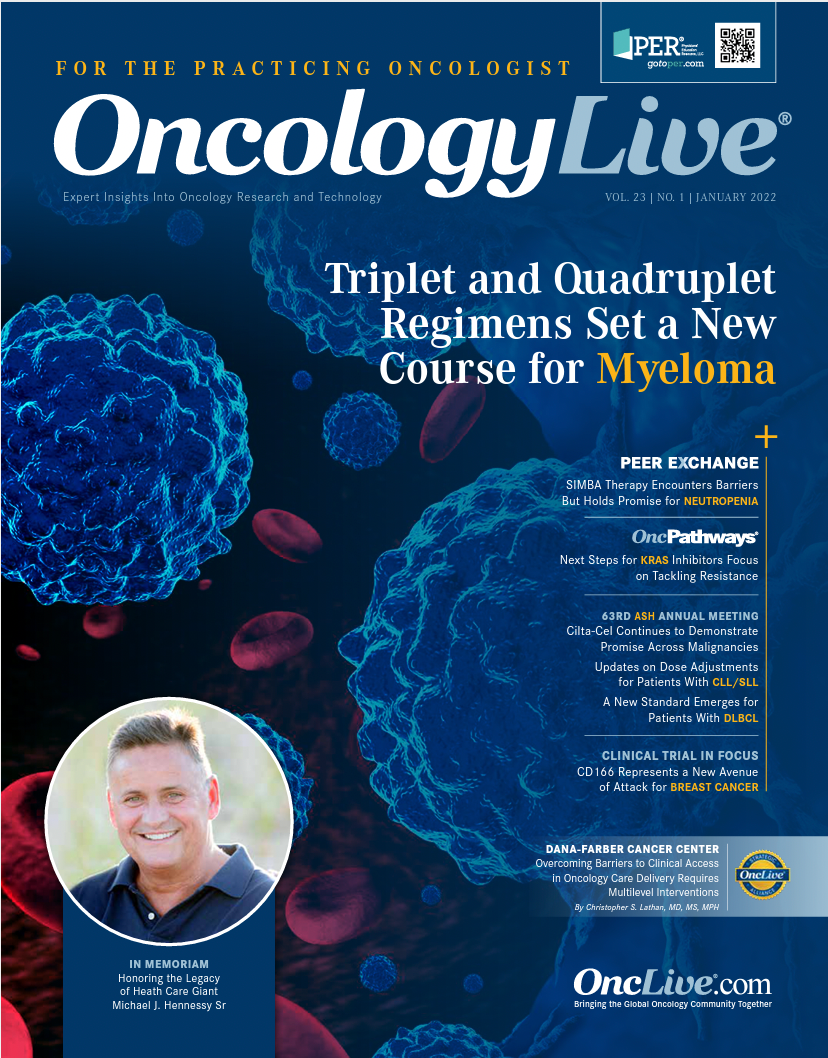Overcoming Barriers to Clinical Access in Oncology Care Delivery Requires Multilevel Interventions
Christopher S. Lathan, MD, MS, MPH, discusses the lack of dissemination and implementation of evidence-based health care delivery innovations focused on addressing disparities in care.
Christopher S. Lathan, MD, MS, MPH

The effects of COVID-19 on our communities revealed the broken safety net of the health care system as images of men and women of color who needlessly lost their lives because of systemic racism flooded our screens and airwaves. Clinicians had been resistant in the past to overtly name systemic racism and classism, choosing instead to talk broadly about the social determinants of health.
Now, the entire cancer community is focused on going beyond descriptive research to consider real effect in broadening access to cancer care for our historically marginalized communities. There are many barriers to remove, but this discussion will focus on the Achilles’ heel of oncology: the lack of dissemination and implementation of evidence-based health care delivery innovations focused on addressing disparities in care. Although this issue is relevant to all cancer treatment sites, the problem starts with the National Cancer Institute (NCI)–designated centers, which have the noble task of improving cancer care via discovery and innovation.
Magnifying Areas of Improvement
Historically, many NCI-designated cancer centers have not been able to meet the needs of underserved communities effectively, given the scope and effect of their cancer center-based research despite years of discussion and good faith efforts by many individuals.1,2 As we now are fully aware of the effect of institutional barriers and systemic racism, we understand there has to be an integrated effort to achieve the treatment equity goal. There must be a focus on clinical access for underserved patients and it must be embedded as part of the clinical and operational f low of the cancer center.1,2 Although the national dialogue on this has been extraordinary, discussions centering on changes in the clinical delivery system have lagged considerably and it has become apparent that many clinical academicians are not aware of the established literature regarding interventions.
Many leaders in oncology systems are unfamiliar with program evaluation literature, have poor access to their own clinical data, and lack familiarity and respect for the decades of innovation and work that has been done to address disparities in cancer care. Leaders want quick fixes for a complex problem and do not appreciate being told that multilevel interventions are the best way to address the access issues.3 Community work is often separate from the both the operations of the cancer center and the majority of the basic, translational, and clinical trials research.4 It is no wonder that many institutions are reinventing the wheel as they try desperately to improve access to cancer care that closes disparity gaps in a demonstrable way.
Steps to Implement Change
There is evidence in results of investigative efforts that can give us some promising tools. The map has been laid out before us and central to any plan to improve clinical access for the marginalized community is the use of navigation as described by Harold P. Freeman, MD.5 The model he developed and published decades ago is an integral part of 3 cancer- specific interventions:
- The work of the Delaware Cancer Consortium6;
- Findings presented by Robert H. Vonderheide, MD, DPhil, at the 2021 American Society of Clinical Oncology Annual Meeting on an intervention to increase access to the University of Pennsylvania’s cancer system7; and
- Findings presented and published by Cykert et al on an intervention to decrease disparities in lung cancer surgery.8
The Delaware Cancer Consortium
The work of the Delaware Cancer Consortium was initially focused on eliminating disparities in colorectal cancer care in the state. Using a multilevel approach, the consortium expanded access to care to uninsured patients, integrated a centralized navigation process, and deepened relationships with community leaders, community health centers, and federally qualified health centers. The results of the efforts showed that the consortium not only eliminated the Black/White disparities in screening, but also narrowed survival differences.6 These findings have been available yet it is hardly mentioned as a model for expanding access and having relevant clinical effect on cancer outcomes. If these were the findings of a specific cancer therapeutic, its use would have spread far and wide by now.
Single-Center Case Study
The University of Pennsylvania undertook a multilevel intervention to align the percentage of African Americans who receive treatment at the center with the percentage of the population that resides in the catchment area.7 In their intervention, investigators described meeting with community leaders, evaluating their clinical system on multiple levels to eliminate potential barriers, implementing a multilevel intervention that included the use of patient navigators along with other systemic changes. Although the results of the intervention have not been peer reviewed, the preliminary data suggest that the institution was successful in improving access and clinical trial accrual.
Access to Thoracic Surgery
Lastly, results published by Cykert et al focused on eliminating treatment disparities in lung cancer surgery.8 This intervention was developed with the community to lessen disparities among Black and White patients who have received a diagnosis of early-stage lung cancer and are candidates for surgery. The intervention combined technical changes in the electronic medical record to allow for a communication between the medical team and patient navigators. The findings demonstrated a decrease in lung cancer mortality for Black participants and White participants.
Next Steps
It is important to note that this is not an exhaustive list of interventions and that they are methodologically distinct. Despite the differences, they are all multilevel interventions developed in collaboration with the community and incorporate patient navigation into the methods.
If we are to move beyond talking about how best to reduce health care disparities and access in cancer care, we need to recognize that the work must be truly transdisciplinary and will require clinicians to recognize and respect a different literature. We must understand that this work is iterative and will require institutions to invest in clinical data systems as well as employ data analysts to move the work. If we really care about improving clinical access, we must admit where we have fallen short and invest our time and resources accordingly. The time is now.
References
- Doykos PM, Chen MS Jr, Watson K, et al. Recommendations from a dialogue on evolving National Cancer Institute-designated com-prehensive cancer center community outreach and engagement requirements: a path forward. Health Equity. 2021;5(1):76-83. doi:10.1089/heq.2020.0156
- Doykos PM, Chen MS Jr, Watson K, et al. Special convening and listening session on health equity and community outreach and engagement at National Cancer Institute-designated comprehensive cancer centers. Health Equity. 2021;5(1):84-90. doi:10.1089/heq.2020.0155
- Carethers JM, Doubeni CA. Causes of socioeconomic disparities in colorectal cancer and intervention framework and strategies. Gastro-enterology. 2020;158(2):354-367. doi:10.1053/j.gastro.2019.10.029
- Polite BN, Adams-Campbell LL, Bawley OW, et al. Charting the future of cancer health disparities research: a position statement from the American Association for Cancer Research, the American Cancer Society, the American Society of Clinical Oncology, and the National Cancer Institute. CA Cancer J Clin. 2017;67(5):353-361. doi:10.3322/caac.21404
- Freeman HP. The history, principles, and future of patient navigation: commentary. Semin Oncol Nurs. 2013;29(2):72-75. doi:10.1016/j.soncn.2013.02.002
- Delaware Cancer Consortium. Turning commitment into action. Delaware Department of Health and Social Services. April 2007. Accessed December 8, 2021. bit.ly/3ozDrET
- Guerra CE, Sallee V, Hwang WT, et al. Accrual of Black participants to cancer clinical trials following a five-year prospective initiative of community outreach and engagement. J Clin Oncol. 2021;39(suppl 15):100. doi:10.1200/JCO.2021.39.15_suppl.100
- Cykert S, Eng E, Walker P, et al. A system-based intervention to reduce Black-White disparities in the treatment of early stage lung cancer: a pragmatic trial at five cancer centers. Cancer Med. 2019;8(3):1095-1102. doi:10.1002/cam4.2005
Lathan’s primary research interests are centered on the effects of race, class, and access to care in cancer outcomes, including racial disparities in lung cancer treatment, differences in access to precision medicine by race and social class, and equitable distribution of new treatment across vulnerable populations. Lathan aims to bridge the gap between research efforts in disparities and the realities of patient care by developing interventions to increase access to high quality care, developed in part through community engagement. He remains a clinical oncologist focusing on lung cancer patients and is the founding director of the Cancer Care Equity Program at the Dana-Farber Cancer Institute, a clinical outreach program that aids in the diagnosis and treatment of cancer for patients at Federally Qualified Health Centers. His research interest focuses on leading systemwide efforts to broaden access to cancer care for historically marginalized groups to reduce disparities and improve health outcomes. Specific projects include (1) development of cancer-focused health equity measurement and data reporting tools; (2) patient navigation integration throughout the cancer service line; and (3) improving uptake of precision medicine in marginalized communities to advance cancer care.




